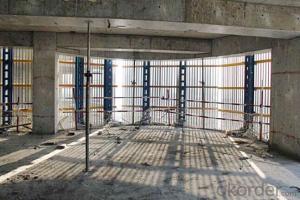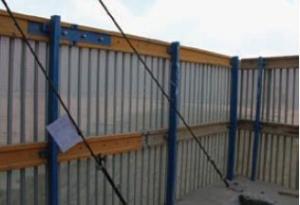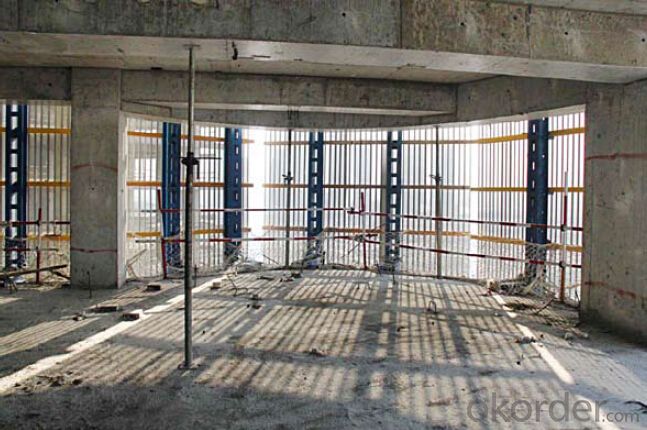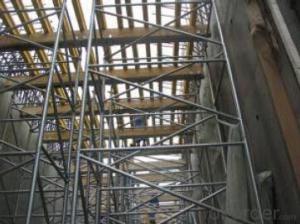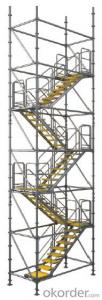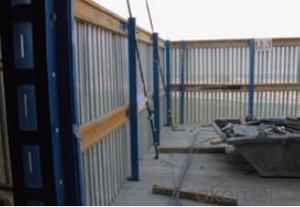Protection-Platform for Formwork and scaffolding system
- Loading Port:
- Tianjin
- Payment Terms:
- TT OR LC
- Min Order Qty:
- 50 m²
- Supply Capability:
- 1000 m²/month
OKorder Service Pledge
OKorder Financial Service
You Might Also Like
Protection Platform PP-50
A kind of new type construction protection system, applying operating platform and safer job
location for construction corps.
Characteristics:
◆ Easy and quick assembling.
◆ Lifted as a group, it is rapid and economic.
◆ Auto-climbing
◆ A safe and reliable anchor system
1. Composition
2. Assembly process of anchor system
(1) Embed V-climbing cone and anchor plate into the slab.
(2) Fix anchor shoe on the slab by tensile bolt.
(3) The fixed anchor shoe.
◆ High work efficiency with work platform and unload platform
◆ High light transmittance with the hollow block
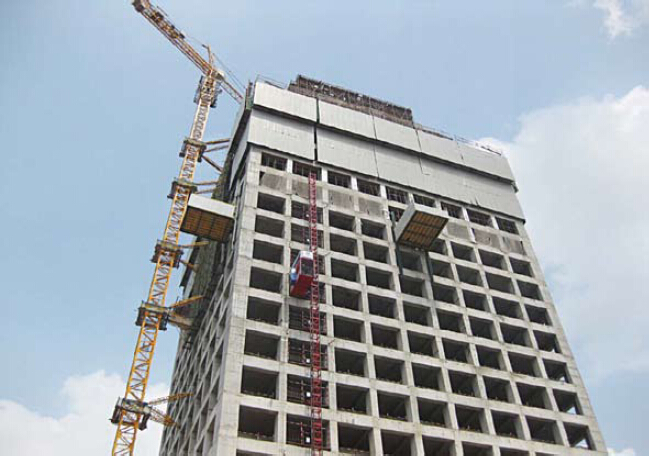

- Q: What are the different types of concrete finishes achievable with steel formwork?
- There are several types of concrete finishes that can be achieved with steel formwork, each offering a unique aesthetic and functional appeal. 1. Smooth Finish: Steel formwork can create a smooth finish on the concrete surface, which is often desired for applications such as walls, floors, and countertops. This finish provides a sleek and polished look and is achieved by using high-quality formwork materials and meticulous installation techniques. 2. Textured Finish: Steel formwork allows for various textured finishes to be achieved on the concrete surface. These textures can range from subtle patterns to more pronounced designs, offering visual interest and enhancing the overall appearance of the concrete. Textured finishes are commonly used in architectural applications to create a visually appealing and distinctive look. 3. Exposed Aggregate Finish: With steel formwork, it is possible to achieve an exposed aggregate finish on the concrete surface. This finish involves removing the top layer of the concrete to expose the aggregates, such as stones or pebbles, embedded within. Exposed aggregate finishes are popular for driveways, walkways, and decorative concrete applications, as they provide a natural and textured appearance. 4. Stamped Finish: Steel formwork can be used to create stamped finishes on the concrete surface, mimicking the appearance of materials like brick, tile, or natural stone. This technique involves pressing molds or stamps onto the concrete before it fully sets, leaving behind imprints that resemble the desired pattern. Stamped finishes are commonly used for patios, pool decks, and other outdoor areas, as they offer a cost-effective alternative to natural materials. 5. Acid Stain Finish: Steel formwork can also be utilized to achieve an acid stain finish on the concrete surface. Acid staining involves applying a chemical solution that reacts with the concrete, creating unique and translucent colors. This finish is often used in commercial and residential spaces where a more rustic and earthy look is desired, as it can enhance the natural variation and character of the concrete. In summary, steel formwork allows for a wide range of concrete finishes to be achieved, including smooth, textured, exposed aggregate, stamped, and acid stain finishes. Each finish offers its own visual and functional benefits, allowing designers and architects to create customized and appealing concrete surfaces for various applications.
- Q: What are the different types of accessories used with steel formwork?
- Steel formwork is commonly enhanced with various accessories to improve its functionality and effectiveness in construction projects. Some examples of these accessories are: 1. Formwork Wedges: These small wedges, made of steel or plastic, secure the formwork panels together. They preserve accurate alignment and stability of the formwork system when concrete is poured. 2. Formwork Clamps: Designed to hold the formwork panels in place, clamps prevent any movement or displacement during concrete pouring and curing. They are typically steel and come in different sizes and designs to accommodate various formwork needs. 3. Formwork Ties: Ties connect the formwork panels and provide structural stability to the system. Available in steel or plastic and in different lengths and types (such as snap ties, wedge ties, and loop ties), they reinforce the formwork. 4. Formwork Braces: Steel braces reinforce and strengthen the formwork system. They support the panels, preventing bending or deformation during concrete pouring. 5. Formwork Hangers: These adjustable steel hangers suspend the formwork panels at the desired height, providing support. They can accommodate different formwork heights and configurations. 6. Formwork Spacers: Spacers maintain uniform spacing between formwork panels, ensuring consistent thickness in concrete walls or slabs. They are available in various sizes and shapes, made of plastic or steel. 7. Formwork Release Agents: These agents prevent concrete from adhering to the formwork surface. Before pouring concrete, they are applied to the panels, allowing for easy removal once the concrete has cured. Overall, these accessories are vital for maintaining the stability, alignment, and functionality of steel formwork systems. They contribute to the efficiency and quality of construction projects by providing reliable support and reinforcement during concrete pouring.
- Q: How does steel formwork handle formwork removal and storage?
- The durability and strength of steel formwork make it highly suitable for the removal and storage of formwork. When it comes to removing formwork, steel formwork can be easily taken apart and removed from the concrete structure. This is mainly because steel formwork is modular, making it easy to dismantle and reassemble. Steel formwork systems often consist of standard-sized panels that can be quickly and efficiently removed by loosening the connecting bolts or clips. This ensures that the formwork can be easily dismantled without causing damage to the concrete structure or the formwork itself. Additionally, steel formwork is lightweight, making it easy to handle during removal and reducing the risk of accidents or injuries. In terms of storage, steel formwork has several advantages. Firstly, it can be stacked and stored in a compact manner, saving space on construction sites or in storage facilities. The modular design of steel formwork panels allows for easy stacking and organization, ensuring efficient storage without taking up excessive space. Furthermore, steel formwork is more resistant to damage from weather conditions compared to other materials like wood or plywood. It can withstand exposure to rain, sunlight, and temperature fluctuations without warping, rotting, or deteriorating. This durability makes steel formwork reliable for long-term storage, as it can be reused multiple times without significant degradation. In conclusion, steel formwork is an excellent solution for formwork removal and storage. Its strength and durability allow for easy dismantling and removal, while its modular design and compact storage capabilities make it ideal for efficient storage. With these advantages, steel formwork contributes to increased productivity and cost-effectiveness in construction projects.
- Q: Can steel formwork be used for dam construction projects?
- Indeed, dam construction projects can make use of steel formwork. This option proves to be both versatile and durable, capable of enduring the intense pressures and extreme conditions inherent in such projects. Its strength and stability allow for customization to meet the dam's specific design requirements. Moreover, steel formwork boasts a notable load-bearing capacity, enabling it to bear the weight of the concrete during the pouring and curing stages. Furthermore, it guarantees a smooth surface finish, thereby ensuring the concrete structure's quality and integrity. What's more, steel formwork can be reused, resulting in reduced costs and environmental impact throughout the construction endeavor. All in all, steel formwork proves to be a dependable and efficient choice for dam construction projects.
- Q: Can steel formwork be used for both monolithic and composite construction?
- Steel formwork is suitable for both monolithic and composite construction. In monolithic construction, concrete is poured continuously to form a solid structure, and steel formwork provides reliable support until the concrete sets and hardens. It is easy to assemble and disassemble, making it efficient for monolithic projects. Composite construction involves combining different materials for a stronger structure. Steel formwork can also be used in composite construction, particularly when concrete is combined with materials like steel beams or columns. The steel formwork acts as a mold, enabling the concrete to be poured and shaped around the other materials to create the desired structure. In summary, steel formwork is a versatile choice for construction projects, including monolithic and composite methods. Its strength, durability, and ease of use make it a popular option for contractors and builders in a wide range of projects.
- Q: How does steel formwork improve construction site safety?
- Steel formwork improves construction site safety in several ways. Firstly, steel formwork is known for its durability and strength. This means that it can withstand heavy loads and pressures, reducing the risk of accidents or collapses during construction. This increased stability ensures the safety of workers on-site. Additionally, steel formwork is designed to be modular and easily assembled, reducing the time and effort required for construction. This helps in minimizing the exposure of workers to hazardous conditions, such as working at heights or in confined spaces. Moreover, steel formwork is highly resistant to fire, which is a crucial safety consideration on construction sites. In the event of a fire, steel formwork can withstand high temperatures and maintain its structural integrity, providing a safe escape route for workers and reducing the risk of injuries or fatalities. Steel formwork also offers a smooth and level surface, which improves the overall safety of the construction site. This eliminates any uneven or unstable surfaces that could potentially cause accidents, such as tripping or falling. Furthermore, steel formwork is reusable and can be easily dismantled and reassembled for multiple construction projects. This not only saves costs but also reduces waste and minimizes the environmental impact of construction activities. By promoting sustainable practices, steel formwork contributes to creating a safer and healthier working environment for construction workers. Overall, steel formwork plays a vital role in enhancing construction site safety by providing stability, fire resistance, efficient assembly, and a smooth surface. It helps to mitigate risks and hazards, ensuring the well-being of workers and improving overall construction site safety.
- Q: How does steel formwork affect the cost of construction?
- The overall cost of construction can be significantly influenced by steel formwork. Despite the need for a greater initial investment compared to traditional formwork materials like wood or plywood, steel formwork offers several advantages that can help counterbalance the increased cost. To begin with, steel formwork is highly durable and long-lasting, enabling it to be reused multiple times. Unlike wood or plywood formwork, steel formwork does not warp, rot, or deteriorate over time. This ability to be reused reduces the necessity for frequent formwork replacements, resulting in material cost savings in the long term. Moreover, steel formwork provides exceptional strength and stability, allowing for the construction of intricate and high-quality concrete structures. This strength permits the usage of thinner formwork elements, reducing the overall weight of the formwork system. Consequently, less labor and equipment are required for handling and installation, resulting in cost savings in terms of manpower and machinery. Furthermore, steel formwork facilitates faster construction cycles. The smooth and precise surface finish provided by steel formwork diminishes the need for extensive finishing work. This streamlined construction process saves time, ultimately reducing labor costs and project timelines. Additionally, steel formwork enhances safety on construction sites. Its robust nature and secure connections guarantee stability during concrete pouring and curing, minimizing the risk of accidents or structural failures. This improved safety aspect can help decrease insurance costs and potential legal liabilities. Lastly, steel formwork is highly adaptable and customizable. It can be easily modified and adjusted to accommodate various design requirements, making it suitable for a wide range of construction projects. This flexibility optimizes material usage and ensures minimal wastage, thereby reducing overall construction costs. In conclusion, although steel formwork may initially incur a higher cost, its long-term benefits such as reusability, strength, speed, safety, and adaptability contribute to overall cost savings in construction projects. Its durability and efficiency make it a cost-effective choice that can positively impact the quality, timeline, and budget of any construction undertaking.
- Q: Are there any specific design considerations for steel formwork construction?
- Yes, there are several specific design considerations for steel formwork construction. Firstly, the formwork should be designed to withstand the weight of the concrete and the pressure exerted during pouring. It should be structurally strong and rigid to prevent any deformation or collapse. Additionally, the formwork design should allow for easy installation, dismantling, and reusability, as steel formwork is often used in repetitive construction projects. Special attention should be given to the joints and connections to ensure stability and prevent leakage. Finally, proper surface finish and alignment should be considered to achieve the desired concrete finish.
- Q: How does steel formwork affect the overall architectural aesthetics of the structure?
- Steel formwork can have a significant impact on the overall architectural aesthetics of a structure. The use of steel as a material for formwork can provide a sleek and modern appearance to the building. Its smooth and rigid surface allows for precise and clean lines, resulting in a more refined and elegant look. Steel formwork also offers great flexibility in terms of design possibilities. It can be easily shaped and molded into complex and intricate patterns, allowing architects to create unique and visually appealing structures. This versatility opens up a wide range of architectural possibilities, enabling the creation of buildings with distinct and eye-catching features. Furthermore, steel formwork provides a high level of structural stability, which enhances the overall aesthetics of the structure. The use of steel ensures that the formwork remains strong and sturdy, even under heavy loads, which is crucial for creating large and imposing architectural designs. The ability to use steel formwork in such constructions allows architects to achieve bold and impressive architectural forms that might not be possible with other materials. In addition to its visual impact, steel formwork also offers various practical advantages. It is a durable and long-lasting material that can withstand harsh weather conditions, making it suitable for both indoor and outdoor applications. Steel formwork is also highly resistant to fire, corrosion, and pests, further ensuring the longevity and integrity of the structure. Overall, steel formwork plays a crucial role in shaping the architectural aesthetics of a structure. Its smooth surface, flexibility in design, structural stability, and durability contribute to creating visually appealing and iconic buildings. By choosing steel formwork, architects can achieve both functional and aesthetic goals, resulting in structures that are not only beautiful but also reliable and long-lasting.
- Q: What are the considerations when designing steel formwork for slabs with openings?
- When designing steel formwork for slabs with openings, several key considerations need to be taken into account. These include the size and location of the openings, the required load-bearing capacity of the formwork, the method of supporting the formwork, and the ease of installation and removal. Additionally, factors such as safety, durability, and cost-effectiveness should also be considered during the design process.
Send your message to us
Protection-Platform for Formwork and scaffolding system
- Loading Port:
- Tianjin
- Payment Terms:
- TT OR LC
- Min Order Qty:
- 50 m²
- Supply Capability:
- 1000 m²/month
OKorder Service Pledge
OKorder Financial Service
Similar products
Hot products
Hot Searches
Related keywords
